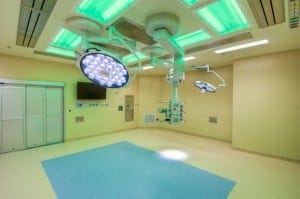It’s a typical scene at most medical centers: a surgeon hunched over a patient, high-output bulbs shining, nurses positioned to assist until the procedure is officially announced a success.
Now picture a classroom of remote students from a nearby college program asking questions and receiving answers from the physician in real-time and staff regarding the live broadcast of the procedure at hand.
While surgery was once a closed-door, private experience between the medical staff and patient, it has evolved into an educational phenomenon where the operating room serves as a live classroom and the procedure becomes a learning experience.
Equipping an operating room to broadcast a live surgery into a college lecture hall is one way innovative medical centers are getting “wired” and adding educational depth to their local college programs. Earlier this year St. Luke’s Magic Valley in Twin Falls, Idaho decided to embark on a high-efficiency 700,000 square foot patient-oriented medical facility, their largest construction project in the history of St. Luke’s regional health system. As part of their focus on creating the most advanced medical center in the region, the staff worked with a nearby nursing and surgical tech program to acquire a grant to make the technology possible for both the college and the medical center.
Unlike other medical colligate programs that tape procedures for later viewing, St. Luke’s streams live surgeries to a classroom full of students with two-way dialogue and visual capabilities. This allows for a two-way conversation where students can ask the medical staff questions about what is happening and the staff can answer and explain their actions as the procedure is taking place. The real-time broadcast provides students with not only the visual aspects of a live surgery, but gives additional interactive instruction as well. It creates an interactive learning environment that spans a broad spectrum of learning styles for a well-rounded learning experience.
There are multiple benefits with this program for both the operating room staff as well as the students. Before this technology was added, the nursing and surgical tech students were only allowed to visit the operating room one at a time during scheduled surgeries to complete their education requirements. This program makes it possible for the medical center to invite anywhere from five to twenty students to join scheduled surgeries remotely while keeping the interactive discussion aspect of a traditional observation intact.
Ideally, operating rooms work to keep as few people in the room as possible to ensure the risk of patient infection remains low. Inviting students to observe and ask questions over a live broadcast means less people in the room during the operation while still maintaining the same level of interaction between the operating room staff and the students.
The operating rooms will also be equipped with multiple flat screens to provide the entire operating room staff a close look at the operating site as well as any pertinent x-rays or charts.
In an effort to become more “wired,” the new St. Luke’s facility is also participating in the “Paperless Clinical Results Project,” a Toyota Lean project that aims to reduce over $70,000 per year in medical chart paper in the new facility. Staff will be able to access electronic medical records using iPads in an effort to increase staff efficiency and legibility, ultimately resulting in faster patient care.
Patti Paxton is the Operating Room Manager for St. Luke’s Magic Valley Medical Center in Twin falls, Idaho.
Throughout the year, our writers feature fresh, in-depth, and relevant information for our audience of 40,000+ healthcare leaders and professionals. As a healthcare business publication, we cover and cherish our relationship with the entire health care industry including administrators, nurses, physicians, physical therapists, pharmacists, and more. We cover a broad spectrum from hospitals to medical offices to outpatient services to eye surgery centers to university settings. We focus on rehabilitation, nursing homes, home care, hospice as well as men’s health, women’s heath, and pediatrics.








